Broadway Palm’s ‘Wizard of Oz’ injects number of surprising elements
 Most reviews of The Wizard of Oz focus on its enchanting storyline. A Kansas tornado whisks a teenage girl and her little dog to a strange land, where she makes new friends, learns from mentors, overcomes threshold guardians and battles a powerful enemy in order to find her way home again. While Broadway Palm honors this timeless story and its iconic characters, its production is special for a number of other reasons.
Most reviews of The Wizard of Oz focus on its enchanting storyline. A Kansas tornado whisks a teenage girl and her little dog to a strange land, where she makes new friends, learns from mentors, overcomes threshold guardians and battles a powerful enemy in order to find her way home again. While Broadway Palm honors this timeless story and its iconic characters, its production is special for a number of other reasons.
The first is an exceptional cast, which includes Melissa Whitworth, who 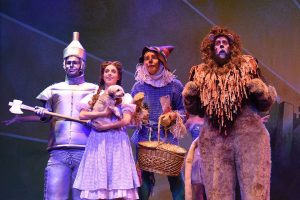 Broadway Palm audiences adored as Mary Poppins.
Broadway Palm audiences adored as Mary Poppins.
“Some of the performers … have played their roles before, some of them over 400 times,” notes Whitworth. “They’ve had the chance to really dig in and make their performances as entertaining, comedic and heartfelt as possible because they never stop trying to seek that 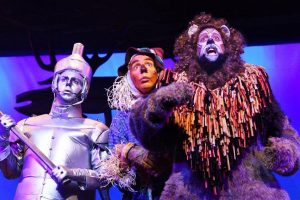 perfect performance no matter how many times they’ve done it.”
perfect performance no matter how many times they’ve done it.”
Then there’s Sarah Cammarata, who has been playing the role of Dorothy Gale for more than half of her life.
“The first time I played Dorothy I was a child. But if you count professionally, once I graduated college and entered the 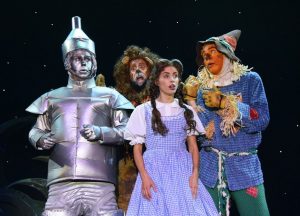 real world of theater, it’s been about six years now. So I actually did it here six years ago at the Broadway Palm and then three years later I did it internationally in China, and now I’m back again.”
real world of theater, it’s been about six years now. So I actually did it here six years ago at the Broadway Palm and then three years later I did it internationally in China, and now I’m back again.”
And Victor Legarreta, who is magnificent as the Cowardly Lion, is returning to the merry old land of Oz for the fifth time, having previously portrayed both 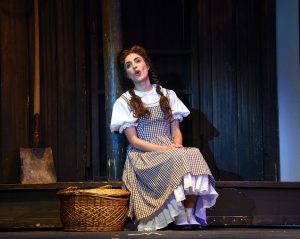 the Scarecrow and the Tin Man, as well as the Lion in the musical’s 2017-2018 national tour.
the Scarecrow and the Tin Man, as well as the Lion in the musical’s 2017-2018 national tour.
While paying homage to America’s most popular movie is important, Director/Choreographer Amy McCleary has also injected a number of surprising new elements into the classic story, as Cammarata explains:
“There is a really cool 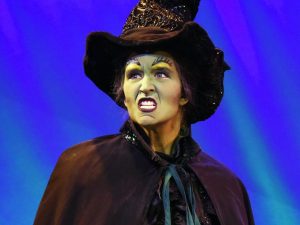 trick with the way that we do the yellow brick road and … there are some really interesting character choices that are that great balance of seeing so much of the classic film that you love but also seeing some really cool new interesting things in the plot.”
trick with the way that we do the yellow brick road and … there are some really interesting character choices that are that great balance of seeing so much of the classic film that you love but also seeing some really cool new interesting things in the plot.”
Broadway Palm didn’t crimp on the show’s technical elements either.
“We have flight, 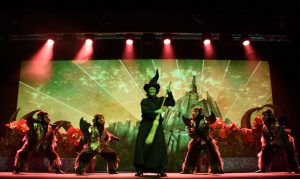 we have fire, we have magic,” Whitworth points out. “It’s a high production value.”
we have fire, we have magic,” Whitworth points out. “It’s a high production value.”
In a show characterized by extraordinary sets, colorful custom costumes, and the kind of dance sequences that are synonymous with McCleary’s signature choreography, what Broadway Palm audiences will long 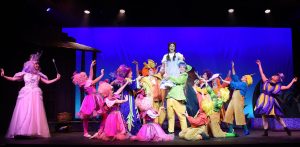 remember are the show’s visuals – such as the little frame farmhouse spinning and spinning in the Kansas twister and Kate Stenzel and Melissa Whitworth flying across the stage – Stenzel as Glinda the Good in her transparent bubble and Whitworth’s Wicked Witch taking
remember are the show’s visuals – such as the little frame farmhouse spinning and spinning in the Kansas twister and Kate Stenzel and Melissa Whitworth flying across the stage – Stenzel as Glinda the Good in her transparent bubble and Whitworth’s Wicked Witch taking 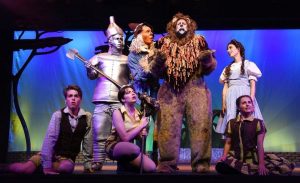 flight on her well-worn broom.
flight on her well-worn broom.
Whitworth is the beneficiary of the show’s other stand-out techno-moments –the smoke and flashes that announce her entrances, the fireball she tosses at the Scarecrow, and her nifty disappearing act as she melts into the floor of her castle after being doused by the bucket of water that Dorothy throws on the 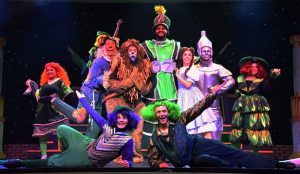 Scarecrow when the witch sets him on fire with her broom.
Scarecrow when the witch sets him on fire with her broom.
But under McCleary’s enlightened direction, The Wizard of Oz is so much more than song, spectacle and pageantry.
“One of the most beautiful things that I think Amy has helped me discover is that this story is far deeper than just a girl who gets lost and goes to a magical land and then tries to go back home,” Sarah Cammarata says. “It really is a coming-of-age story and it really is about a young girl who’s kind of entering that rebellious stage of womanhood and she really finds her inner strength and she accesses things she didn’t know she had within her to sort of become the fearless leader of the group and find her way back home.”
While Dorothy’s outer problem may be Miss Gulch’s antipathy toward Toto and her aunt and uncle’s failure to stand by her, this production underscores Dorothy’s inner dilemma. She’s missing an important piece of her psyche. Her parents are dead. Her aunt and uncle don’t seem to have time for her. She feels like an imposition and doesn’t feel at home anymore. So in essence, her trip to Oz is a metaphorical quest for completion.
As she passes through corn fields, apple orchards, wild forests and poppy fields, Dorothy comes to terms with her feelings about the weak male role models in her life, learning life-altering lessons about her own resourcefulness, caring and nerve. But it’s through the Wicked Witch that she finally confronts her own inner demons, as Melissa Whitworth explains.
“The Wicked Witch isn’t just an outside obstacle, you know. The Wicked Witch is that voice in your head saying mean things to you and trying to hold you down and keep you back from believing in yourself and being true to your heart and using your brain and having courage.”
One big difference between McCleary’s vision and the movie version of Dorothy’s encounter with the Witch is Dorothy’s pluck.
“In the movie, Dorothy is sitting. She’s crying. She’s not really fighting for herself. She’s just reacting, but she is kind of a victim,” observes Whitworth. “In our version, Dorothy is right up in the wicked witch’s face, fighting back and standing up for herself. I think that’s just a really exciting version of a way to produce this show.
In her dealings with the Witch and even the Wizard, Dorothy has another powerful ally, Toto, who symbolizes her intuition. That’s really what Miss Gulch and the Wicked Watch want to destroy. But that’s the one thing Dorothy won’t let them or anyone else do.
In the end, Dorothy learns that home is not a place but a state of mind and solutions to life’s most challenging problems emanate from within. No one needs to rescue this girl. She already possesses the brains, heart, courage and intuition to save herself.
This deeper understanding translates into a more profound experience not only for the cast, but for the audiences who see the show. On that subject, Sarah Cammarata gets the last word:
“There are so many intricate and intimate moments that we share as cast members that we share with various members of the ensemble … whether they are the monkeys or the Ozzians or the Winkies. And even if it’s not an exact tangible moment from the audience’s perspective, it’s still so important because we feel it, we connect on it and then that energy is, I think, translated to the audience of a show that’s so much more in depth, has so much more meaning and is just so full.”
NOTES AND FAST FACTS
- While Casablanca, Citizen Kane, Vertigo and The Godfather are consensus choices for Hollywood’s greatest films, the Library of Congress states that The Wizard of Oz is America’s most-watched movie of all times.
- In 2001, the American Film Institute named The Wizard of Oz the 43rd most heart-pounding suspenseful film in history.
- To contrast the ordinary world of Kansas with the magical world of Oz, the filmmakers shot the Kansas scenes in stark black-and-white and the scenes in Oz in Technicolor. Oz was one of the very first films that ever used the latter technology.
- MGM originally wanted Shirley Temple to play the part of Dorothy.
- MGM also wanted to cut “Somewhere Over the Rainbow,” arguing that it slowed the action and disrupted the quick pacing in the rest of the story. Fortunately, Oscar-winning lyricist Arthur Freed (Gigi, An American in Paris, Singin’ in the Rain) insisted that the song be retained.
- Buddy Ebsen was originally cast as the Tin Man, but he had to be replaced by Jack Haley after falling ill due to aluminum poisoning from the make-up that was applied to Ebsen’s face and hands.
- The movie and musical are based on a book written in 1900 by L. Frank Baum, who went on to write 12 more installments which were the analog to the modern-day fantasy series Harry Potter.
- Oddly, The Wizard of Oz did not make any money in the year it was released. In 1939, the world was on the brink of war, the country was still recovering from the Great Depression and competition that year for theater patron was stiff. Gone with the Wind, Mr. Smith Goes to Washington and Stagecoach all came out in the same year, which is widely regarded as the greatest single year in film history.
July 17, 2022.














 Tom Hall is both an amateur artist and aspiring novelist who writes art quest thrillers. He is in the final stages of completing his debut novel titled "Art Detective," a story that fictionalizes the discovery of the fabled billion-dollar Impressionist collection of Parisian art dealer Josse Bernheim-Jeune, thought by many to have perished during World War II when the collection's hiding place, Castle de Rastignac in southern France, was destroyed by the Wehrmacht in reprisal for attacks made by members of the Resistance operating in the area. A former tax attorney, Tom holds a bachelor's degree as well as both a juris doctorate and masters of laws in taxation from the University of Florida. Tom lives in Estero, Florida with his fiancee, Connie, and their four cats.
Tom Hall is both an amateur artist and aspiring novelist who writes art quest thrillers. He is in the final stages of completing his debut novel titled "Art Detective," a story that fictionalizes the discovery of the fabled billion-dollar Impressionist collection of Parisian art dealer Josse Bernheim-Jeune, thought by many to have perished during World War II when the collection's hiding place, Castle de Rastignac in southern France, was destroyed by the Wehrmacht in reprisal for attacks made by members of the Resistance operating in the area. A former tax attorney, Tom holds a bachelor's degree as well as both a juris doctorate and masters of laws in taxation from the University of Florida. Tom lives in Estero, Florida with his fiancee, Connie, and their four cats.